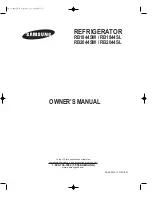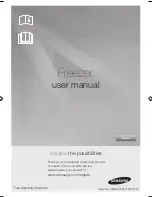
Page:
9
Page:
8
User Manual:
User Manual:
Troubleshooting
Fault
Possible Cause
Solution
The Chest Freezer
doesn’t operate.
Not plugged in.
Plug the Chest Freezer in.
The circuit breaker has tripped,
or a fuse blown.
Replace any blown fuses or reset tripped circuit
breakers.
The freezer temperature is set at
“0/OFF”.
Increase the freezer temperature.
The compressor turns on and off
frequently.
The room temperature is hotter than normal.
Try to bring the room temperature down.
A large amount of food has been added to the
freezer.
Give the Chest Freezer time to return back to
your desired temperature setting.
The door is left open too often.
Try to minimise the door being opened for
sometime.
The door is not closed completely.
Close the door completely and ensure a com-
plete seal.
The temperature control is not set properly.
Change the temperature control to your desired
setting.
The door gasket doesn’t seal properly.
Try cleaning the door gasket seals with warm
soapy water. If this still doesn’t improve the seal,
you may need replacement gasket seals from
either a refrigeration specialist or Residentia
Group.
The freezer doesn’t have the correct clearances.
Ensure your Chest Freezer has been installed in
an appropriate space and has the correct clear-
ances (as per this instruction manual).
There has been a recent power outage.
Give the refrigerator a few hours to return to the
desired temperature setting.
The temperature inside the Chest
Freezer is too warm.
The temperature control is set too warm.
Turn the temperature control down to a cooler
setting and leave for several hours for the tem-
perature to stabilise.
The door is kept open too long is opened too
frequently.
Try to minimise the door being opened for
sometime.
The door gasket doesn’t seal properly.
Try cleaning the door gasket seals with warm
soapy water. If this still doesn’t improve the seal,
you may need replacement gasket seals from
either a refrigeration specialist or Residentia
Group.
The freezer doesn’t have the correct clearances.
Ensure your Chest Freezer has been installed in
an appropriate space and has the correct clear-
ances (as per this instruction manual).
There has been a recent power outage.
Give the refrigerator a few hours to return to the
desired temperature setting.
Fault
Possible Cause
Solution
The temperature inside the Chest
Freezer is too cold.
The temperature control is set too cold.
Turn the temperature control to a warmer set-
ting and allow several hours for the temperature
to stabilise.
There is a popping or cracking
sound when the compressor
comes on.
Metal parts undergo expansion and contraction, as
in hot water pipes.
This is normal and the sound will level off or
disappear as the freezer continues to run.
There is a bubbling or gurgling
sound like water boiling.
The refrigerant (used to cool the chest freezer) is
circulating throughout the system.
This is normal.
The chest freezer is vibrating.
The floor is uneven.
Check to ensure that the chest freezer is level.
Level the freezer using wedges if required.
The freezer is touching the wall.
Remove the freezer from the wall and ensure
adequate clearances.
Moisture forms on inside freezer
walls.
The chest freezer door is slightly open, causing
cold air from inside the freezer to meet the warm
moist air from outside the freezer.
Ensure the chest freezer door completely closes
and has a complete seal.
The Chest Freezer door won’t
completely close.
The freezer isn’t level.
Re-level the Chest Freezer.
The gasket seals are dirty.
Use warm soapy water to clean the gasket seals.
The storage basket is out of position or there is too
much food.
Re-position the storage basket to ensure it
doesn’t interfere with the door, or remove any
excess food preventing the door from closing.

























